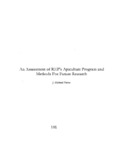An assessment of REP's apiculture program and methods for future research
Citation
Pierce, J. M. (1998). An assessment of REP’s apiculture program and methods for future research. Research Reports (1998): Economic Studies, Vol - XIII, 118–194.Abstract
The Rural Enterprise Project's apiculture program is at an important juncture in its
progression toward becoming a full scale RDP program. REP's goal is to develop businesses that
can eventually be implemented across all of the RDP branches. After a full investigation, the
possibility of full implementation is not likely.
After my initial research it became clear that the current program had needs that had to be
met in order for expansion to be possible. The need was a different bee species that produced more
honey, did not abscond from the hive, and required less land for VO members. If these cannot be
met, then, expansion of the current program cannot be achieved to facilitate full RDP
implementation.
The most promising alternative we found was the implementation of an artificial queen bee
production center (AQPC). If implemented the AQPC would greatly increase the returns to VO
members from a current average income of Tk 2500 per year to Tk 24,000.
Unfortunately however, while the financial benefit to VO members would be very positive,
the investment required by BRAC coupled with a negative return mean that AQPC is not a good
investment. There are also human resource and logistical demands that BRAC cannot currency over
come in order for AQPC to be achieved. AQPC requires a skilled and formally trained apiculturist
in order for successful implementation to be achieved. Another problem is the time necessary for
AQPC to be started.
The investment of TK 7,475,000 with income from honey production of at TK 2,640,000
yields a return on investment of a very disappointing .35. This is simply too low. The breakeven
timeframe (exaggerated by the three-year startup period) is a lengthy seven years. This is simply too
high. Other BRAC program investments such as sericulture and the BRAC dairy all have had
significandy higher returns on investment and shorter payback periods.
From a human resource standpoint BRAC does not currendy have access to an individual
who can carry out the implementation of an AQPC. To do so requires a person who is skilled and
trained in the raising and breeding of apis melifera bees. There is currently no such person available
in Bangladesh. The logistical and time demands are currendy unacceptable. BRAC would have to
wait a minimum of three years before an AQPC could be implemented. This is due to the time
necessary to procure the necessary quantity and quality of melifera bees.
What is important for BRAC beyond realizing that investing in artificial queen production,
is how these conclusions were reached. Through the use of a business inquiry, as opposed to that of
traditional social science, and fundamental financial analysis tools this conclusion was able to be
reached quickly and effectively and with minimal research cost. If BRAC can replicate this type of
research in its RED division BRAC and RDP will benefit from timely and cost effective information
dissemination.
In sum, based on the above findings, I recommend that RDP management consider the
possibility of continuing the existence of the apiculture program as a supplementary income
generating activity, despite the impossibility of expansion and full implementation across all RDP
branches.

